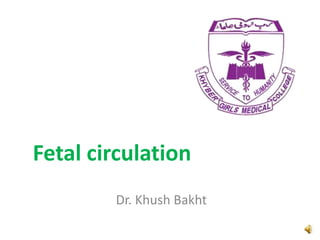
Fetal circulation
- 1. Fetal circulation Dr. Khush Bakht
- 2. 1. What is the oxygenation status of the blood in the umbilical arteries? In the umbilical vein? 2. What are the three fetal shunts? What vessels or heart chambers do they connect? What organ does each shunt bypass? 3. What changes do you expect at birth? Objectives:
- 4. Introduction • During pregnancy, the fetal circulatory system works differently than after birth. • The fetus is connected by the umbilical cord to the placenta. This is the organ that develops and implants in the mother's uterus during pregnancy. • Through the blood vessels in the umbilical cord, the fetus gets all needed nutrition and get rid of waste products.
- 5. Key differences between fetal and adult circulation • The lungs and liver both do not serve significant functions prior to birth. • Gas exchange occur at the placenta. • Detoxification and metabolism are primarily controlled by the mother’s liver, and nutrient and waste exchange occurs at the placenta, as well. • Notably, these two organs are both underdeveloped so the developing child’s body constructs three shunts to actively direct blood away from these organs
- 7. • Fetal circulation consequently differs from the adult one predominantly due to the presence of 3 major vascular shunts: • Ductus venosus - in the liver between the umbilical vein and IVC • Foramen ovale - in the heart between the right and left atrium • Ductus arteriosus - in the aortic arch between the pulmonary artery and descending aorta
- 8. • The main function of these shunts is to redirect oxygenated blood away from the lungs, liver and kidney.
- 10. Foramen Ovale • There is a direct connection between the right and left atria , blood from the right atrium flows directly into the left via the foramen ovale and thus goes around the pulmonary circulation system. This shunt allows a normal development of the left atrium and the left ventricle in that the cardiac musculature on this side is trained.
- 12. Ductus arteriosus • The right ventricle could also not develop correctly when no blood would flow via the right side. Thus in fetal hearts blood also flows in small amounts from the right atrium via the tricuspid valve into the right ventricle but, going through the truncus pulmonalis it takes a shortcut into the aorta via the ductus arteriosus.
- 14. • Oxygenated blood is carried from the placenta to the foetus in the umbilical vein, most of which then passes through the ductus venosus to the IVC while some blood supplies the liver via the portal vein.
- 15. • The blood from the placenta that has been enriched with oxygen and nutrients gets via the umbilical vein to the liver, part flows through it and part bypasses it via the ductus venosus and gets via the v. cava inferior into the right atrium.
- 16. • Blood from the liver drains into the IVC through the hepatic veins. • The blood in the IVC is a mixture of oxygenated blood from the umbilical vein and desaturated blood from the lower limbs and abdominal organs (e.g. the liver).
- 17. • This blood enters the right atrium where most of it is directed to the left atrium through the foramen ovale and from here to the left ventricle and aorta.
- 19. After birth With birth, a change from parallel flow through the heart to a serial one gradually takes place. The following changes must occur: • The gas exchange takes place in the baby's lungs. • By cutting the umbilical cord, the placental circulation system is switched off. • The fetal heart shunts become closed
- 20. • On the other hand, with the cutting of the umbilical cord following birth, the placental low resistance area also disappears and the peripheral resistance increases in the systemic circulation.
- 22. • With the activation of breathing the lungs becomes distended, the capillary network dilated and their resistance is reduced drastically so that a rich flow of blood can take place. As a consequence, the pressure in the right atrium sinks in comparison with that of the left one.
- 23. • This pressure turn around in the atria causes the septum primum to be pressed against the septum secundum and the foramen secundum becomes functionally closed. Towards the end of the first year, it has also grown together in 99% of the babies --> The shunt between the left and right atrium is closed.
- 25. • The pressure in the aorta is now higher than that in the truncus pulmonalis and the right- left shunt via the ductus arteriosus that is present before birth is turned around into being a left-right shunt. The pO2 pressure in the aorta increases since the blood is now oxygenated directly in the baby's lungs.
- 26. • This increase in pO2 triggers a contraction of the smooth musculature in the wall of the ductus arteriosus and thereby to a functional seal. After a few weeks or months this shunt via the ductus arteriosus is definitively obliterated and the remnant is known as the ligamentum arteriosus.
- 27. Fetal remnants • The severing of the baby's umbilical cord leads to the obliteration of the umbilical vessels, primarily through active constriction of their muscular layer. Only the proximal part of the umbilical arteries stays open as the superior vesical artery. • The distal part forms the medial umbilical ligament on both sides in the anterior abdominal wall. The umbilical vein transforms itself into the ligamentum teres hepatis.
